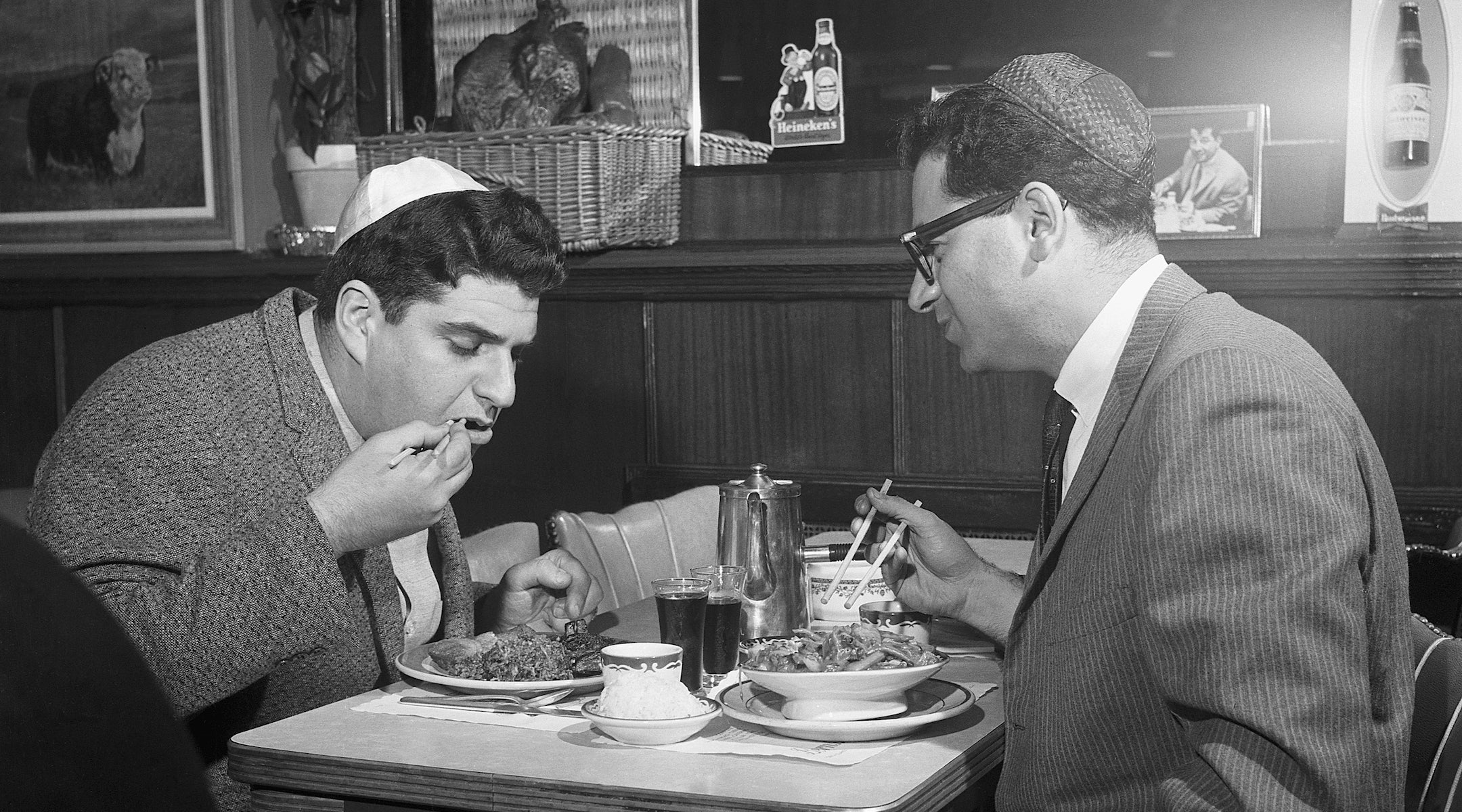Uncategorized
How long before new TikTokers see Nazi content? 75 minutes, according to a Jan. 6 committee test
WASHINGTON (JTA) — The committee investigating the Jan. 6, 2021, attack on the U.S. Capitol wanted to test how fast it took social media to get to radical content. The answer, when it came to TikTok and Nazis, was just over an hour.
It took TikTok 75 minutes to deliver Nazi content to a new user who did not seek it, the committee found, according to a report Thursday in Rolling Stone. The magazine is one of a number of publications reviewing the committee’s final release of documents as the U.S. House of Representatives transitions from Democratic to Republican control.
Committee staffers were testing a theory that social media giants were reluctant to police right-wing extremist content in part because of pushback from then-President Donald Trump and his supporters who argue that such controls inhibit conservative speech.
The Jan. 6 riot, which resulted in multiple deaths, was carried out by supporters of Trump who believed his false claim that he had won the 2020 election. That lie spread on social media, where right-wing accounts were some of the most seen during the period between the election and Jan. 6, after which several social media giants, including Twitter, banned Trump.
The staffers on the committee’s social media team invented Alice, a 41-year-old woman from Acton, Massachusetts. It took “Alice” 75 minutes of scrolling without prompts or interactions to get to Nazi content, the staffers reported.
The social media team said in a draft summary that “Alice” was “just one of the Committee’s experiments that further evidenced the power of TikTok’s recommendation algorithm in creating rabbit holes toward potentially harmful content.”
The incoming Republican majority in the House, which includes a substantial portion of Trump backers, has indicated that it will seek to bury as much of the findings of the Jan. 6 committee as it can. Meanwhile, legislators on both sides of the aisle have said they plan to scrutinize TikTok, which is owned by a Chinese company, because of its presentation of harmful content and its potential security risks.
—
The post How long before new TikTokers see Nazi content? 75 minutes, according to a Jan. 6 committee test appeared first on Jewish Telegraphic Agency.
Uncategorized
Waiting on line on Christmas is a time-honored New York tradition — was it ever thus?

At 6 a.m., the morning before Christmas, Charles Licata was waiting outside the door of Russ & Daughters, two hours before the century-old Manhattan appetizing store opened. Each Christmas Eve for the past 42 years, Licata, jones this time by a family member and a friend, has made the hour-long drive from central New Jersey. “I like to be first in line,” he told me.
Licata, who manufactures granite countertops, told me he was hosting 40 for a traditional Italian feast of seven fishes on Christmas Eve, and on Christmas Day, his family had plans to devour another seven fishes and then some. “We got sable, lox, caviar, the spreads, pickled herring, tuna fish salad, hot and cold smoked salmon,” he started to list, before adding, “we got everything.”
Nikki Russ Federman, the fourth-generation owner of Russ & Daughters, instantly greeted Licata who she recognized from years past. By 9 a.m., she was hustling off to the shop’s Brooklyn bakery because they were already running out of bagels.
The Christmas Eve crowds rival Erev Yom Kippur and they grow throughout the day.

“Christmas is a Jewish holiday,” Russ Federman quipped.
For Licata, the line itself, with its banter and camaraderie is part of the ritual, except queuing at Russ & Daughters isn’t traditional. Lower East Side Jews didn’t wait in line; they jostled at deli counters and mobbed pushcarts.
“When I arrived on the scene in 1978 to take over the business,” third-generation owner Mark Russ Federman recounted in his 2013 book Russ & Daughters, “I discovered that there had never been a real attempt to implement a method to maintain crowd control and customer flow.”
First, the lox slicers behind the counter would pick out their regulars from the crowd, and then call “Who’s next?” To which, according to Mark Russ Federman, several elderly women would yell in their Yiddish-inflected English, “My next.” Mayhem would ensue.

“Grandpa Russ, my parents, and my uncles and aunts,” wrote Mark Russ Federman, “felt that having customers take a number from a machine and wait their turn was insulting, impersonal, and too ‘uptown.’”
It was during the Yom Kippur rush of 1978 that Russ Federman established a numbered ticketing system, turning the huddled mass of customers into an orderly line — something he saw as both more efficient for business and fairer for the customers. Since then, the appetizing store’s line has only grown, as have lines throughout the city.
Weathering the wait for Russ & Daughters seems more legit than camping out for the latest TikTok trend. Since the pandemic, lines in New York have become ubiquitous — for oversized pastries, for stunt croissants, for hype pizza. This past spring, a Saturday Night Live skit joked that a New Yorker’s favorite pastime is to “wait in a big dumb line.”

Waiting on line for West Village brunch often feels performative, but for Licata at Russ & Daughters, it isn’t about clout, it’s about continuity. It was a Jewish friend who first brought bagels and lox over for Christmas breakfast at Licata’s home decades ago. “I’m just carrying the tradition forward,” he said.
Down the block, most every year, Jeremy Kahn and his family make a pilgrimage from Washington, D.C. to Katz’s Deli. This past week, he was shocked to find that, even at the off-time of 4 p.m., the line still stretched to the corner. He speculated that there were more tourists. “I thought we’d be able to just walk right in,” he said.
After the 30 minute-plus wait at Katz’s, customers hungry for pastrami take a ticket at the door; they must sort into new lines to wait their turn with a cutter at the counter. And before leaving, customers must again wait their turn at the cashier’s line.
For Kahn, the wait is worth it. “This is where my grandfather would come to eat,” he said, and now he was taking his two young children and his father. “It means something that there is a line to get in. People are willing to wait in the cold.”
Katz’s with its shared cafeteria tables is known for its hustle and bustle, but things feel orderly compared to how it once was. In 1966, the iconic cheap eats guide, Underground Gourmet, deemed Katz’s “the largest, nosiest, busiest, and sloppiest delicatessen in Manhattan.” The guide’s authors, the illustrators and graphic designers Milton Glaser and Jerome Snyder, described ordering as a “struggle” that involved having to “muscle your way up to the endless serving counter and try to make yourself heard.”
Standing on line was foreign enough to Jewish immigrants that the Forverts mostly referred to queues, not by the Yiddish word “rey” (meaning row), but with the English “line,” spelled out in Hebrew letters. In 1930, the Forverts reported that boxing fans were waiting on long lines in the cold and rain to watch a Jackie Kid Berg lightweight championship bout at Madison Square Garden, but Jews at the time mostly seemed to be lining up at Depression-era soup kitchens and unemployment lines in the U.S. or, worse, for handouts at refugee centers in Europe.
It’s not just Jews who were late to line up; lines are actually a fairly modern phenomenon. Often cited as containing the first description of a queue in English is Thomas Carlyle’s 1837 book The French Revolution, which described Parisians lining up at bakers’ shops during a famine. By World War II, queuing had become commonplace in rationing-era Britain.

Lines were then associated with shortages and bureaucracy; now they represent wealth and leisure. There are still long waits at the DMV and over-burdened food pantries, but today, many lines are fueled by social media. A long line at a bakery signals that their $8.50 pistachio rose croissant is popular; joining the line gives you online bragging rights, not joining risks FOMO.
My friend Miriam Berger, a 91-year-old Manhattanite, says she has no memory of these types of lines in the 20th century. “I have no patience to stand on a line for anything,” she told me, “probably because such behavior didn’t exist in my growing-up environment.”
We still manage to do much without lines. We squeeze into rush hour subway cars, flag down bartenders at crowded pubs, and hail cabs. At times, it feels cut-throat, but there’s an unspoken etiquette — someone waves you into a lane, a stranger holds the door.
Lines promise efficiency and equity, but the first-come-first-serve system easily breaks down. There are cutters, professional line waiters, and ways to pay your way to the front of the line with priority passes and VIP options for most anything.
And very often, there are ways to avoid lines altogether. At the end of his book, Mark Russ Federman writes that when his daughter Nikki and his nephew Josh entered the business in 2001, they started online ordering. “This wasn’t the way the Russ family did business,” he initially thought before he accepted the idea. “If you wanted to buy our fish, you came to the store. If you wanted to place an order over the phone, we had to recognize your voice or know your family.”
Now, Russ & Daughters ships nationwide, and with delivery apps, lox and herring can be ferried almost instantly to your door on an electric moped.
That’s too uptown for my tastes. I’d rather take a number.
The post Waiting on line on Christmas is a time-honored New York tradition — was it ever thus? appeared first on The Forward.
Uncategorized
The data is in: For many in the Northeast, Christmas isn’t Christmas without Chinese food

It’s not just a myth that Jews head to Chinese restaurants on Christmas. It’s science!
Sort of. A new report from the financial services company Coventry Direct claims to have quantified the trend. The report analyzed search data for “Chinese food near me” during the week of Christmas from 2020 to 2024, and found that the Northeast dominated the results.
The top five states included Delaware, Rhode Island, Connecticut, New Jersey and New Hampshire, while New York, which is home to the largest Jewish population in the country, came in seventh place. Under the assumption that Jews are overrepresented in the Northeast, the study confirms that Coventry Direct is not peer-reviewed.
The study also analyzed Google search trends over the past year to find the top-searched Chinese food dish in each state. While Szechuan chicken was the most popular dish, taking first place in eight states, New York’s most searched item was Buddha’s Delight, a — IYKYK — vegetarian stew.
The Jewish Christmas tradition was famously referenced during Elena Kagan’s United States Supreme Court confirmation hearings in 2010 when she was asked where she was on Christmas day:
“You know, like all Jews, I was probably at a Chinese restaurant,” replied Kagan.
In recent years around Christmas, social media has also been flooded with images of a sign where the seemingly fictional “Chinese Restaurant Association” of America thanks its Jewish diners for their patronage.
“The Chinese Restaurant Association of the United States would like to extend our thanks to the Jewish people,” the sign reads. “We do not completely understand your dietary customs … but we are proud and grateful that your GOD insist you eat our food on Christmas.”

Two men enjoy Chinese cuisine prepared by Chinese chefs within the guidelines of kosher food preparation at a restaurant. (Getty Images)
But the now-ubiquitous tradition of Jews eating Chinese food on Christmas traces back to the early 20th century, when Jewish immigrants began carving out distinctly American rituals of their own. If for no other reasons, Chinese restaurants were more likely to be open on Christmas.
A classic 1993 study on the tradition, “New York Jews and Chinese Food: The Social Construction of an Ethnic Pattern,” by Gaye Tuchman and Harry Levine, traced the Jewish affinity for Chinese food to a few factors: Chinese restaurants at the time “welcomed everyone,” offered flavors familiar to an Eastern European Jewish palate and were considered a “sophisticated” dining experience for new-ish, Jewish Americans stepping outside their comfort zones.
While Chinese restaurants do not typically offer kosher fare, Tuchman and Levine also argued that Chinese restaurants were viewed as “safe treyf” because Chinese cuisine rarely mixes milk and meat and ingredients like pork and shrimp are chopped into hard-to-identify pieces.
To celebrate the longstanding tradition, a comedy club in New York’s East Village is set to host “Kosher Chinese: The Comedy Show,” with patrons enjoying kosher dumplings and an “unapologetically alternative holiday spirit we all secretly love.” In San Francisco, the 33rd Annual Kung Pao Kosher Comedy show kicks off tonight, and runs through Friday, Dec. 26.
From Massachusetts to Ohio, Jewish delis have also planned their own Chinese-inspired menus to mark the tradition.
This article originally appeared on JTA.org.
The post The data is in: For many in the Northeast, Christmas isn’t Christmas without Chinese food appeared first on The Forward.
Uncategorized
StopAntisemitism names Tucker Carlson ‘Antisemite of the Year’ as 2024 winner Candace Owens ramps up anti-Jewish rhetoric
(JTA) — The activist group StopAntisemitism has awarded the conservative personality Tucker Carlson its ignominious honor of “Antisemite of the Year,” citing his frequent invocation of classic antisemitic stereotypes.
The announcement comes as Carlson sits at the center of controversy on the American right about whether extremists should be welcomed in the Republican Party. It also marks the second year in a row that StopAntisemitism has selected a right-wing figure for its accolade, after years of awarding the mantle to mostly left-wing figures.
“Carlson mainstreams antisemitism by platforming and praising Holocaust revisionists and Nazi apologists, while hiding behind irony and plausible deniability,” the group said in a statement. “By legitimizing extremist voices and weaponizing conspiratorial imagery at massive scale, he has helped drag antisemitic ideas back into the mainstream.”
A watchdog presence with more than 300,000 followers on X, StopAntisemitism regularly mobilizes against activists and social media posts. The group has faced criticism for what some perceive as an inordinate focus on Muslim personalities, pro-Palestinian actions and non-prominent individuals. Its defenders deny that, pointing out that StopAntisemitism also regularly spotlights neo-Nazis and Holocaust deniers on the right.
Its finalists for Antisemite of the Year included pro-Palestinian celebrities Ms. Rachel, Cynthia Nixon and Marcia Cross; mixed-martial-arts athlete and Holocaust denier Bryce Mitchell; two personalities associated with left-wing network The Young Turks; and social media personalities on both the far left (Guy Christensen) and far right (Stew Peters).
Carlson received the accolade on Sunday night, at the end of a weekend in which he was a keynote speaker at the convention of Turning Point USA, the young-conservatives group founded by Charlie Kirk, who was assassinated this fall. In its announcement, StopAntisemitism noted Carlson’s speech at Kirk’s memorial service, in which he described the murder of Jesus in a way that both his critics and fans interpreted as implying that Jews or Israelis had been behind Kirk’s assassination.
At the convention, the Jewish pundit Ben Shapiro continued his campaign against Carlson and Carlson declared himself to free of the anti-Jewish animus that he has long been criticized as propagating.
“Let me just affirm one final time. Not only am I not an antisemite — and I would say so if I was — I’m not an antisemite for a very specific reason,” Carlson said in his speech. “Not because it’s unpopular or my donors don’t like it. I don’t have any donors. I’m not an antisemite because anti-semitism is immoral in my religion. It is immoral to hate people for how they were born.”
It was the same explanation that Vice President JD Vance offered earlier this month when he said in an NBC News interview that he believed antisemitism is wrong.
In his own speech to Turning Point USA’s AmericaFest, Vance again refrained from criticizing extremists in the Republican Party, saying that he opposes “purity tests” for inclusion in the conservative movement. He also said he believed that antisemitism in the United States was being fueled by “a real backlash” against U.S. aid to Israel..
As the convention was underway, last year’s “Antisemite of the Year,” the right-wing streamer Candace Owens, embarked on a four-hour broadcast eviscerating Shapiro; amplifying antisemitic theories, including that Jews controlled the slave trade; and promoting a classic work of antisemitism by August Rohling, a German Catholic who believed in the blood libel and argued that the Talmud is a secret guide used by Jews for nefarious purposes. Rohling died in 1931.
The post StopAntisemitism names Tucker Carlson ‘Antisemite of the Year’ as 2024 winner Candace Owens ramps up anti-Jewish rhetoric appeared first on The Forward.

